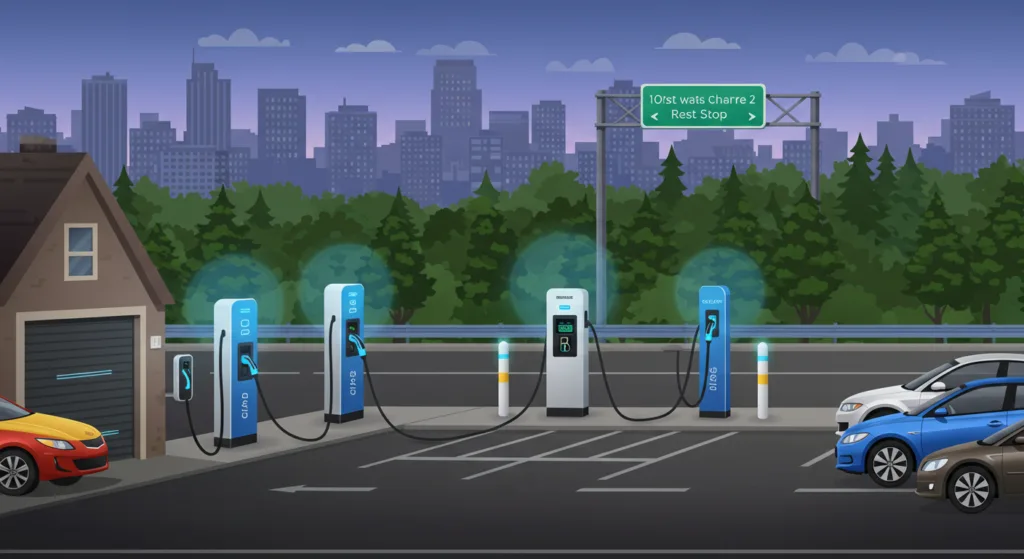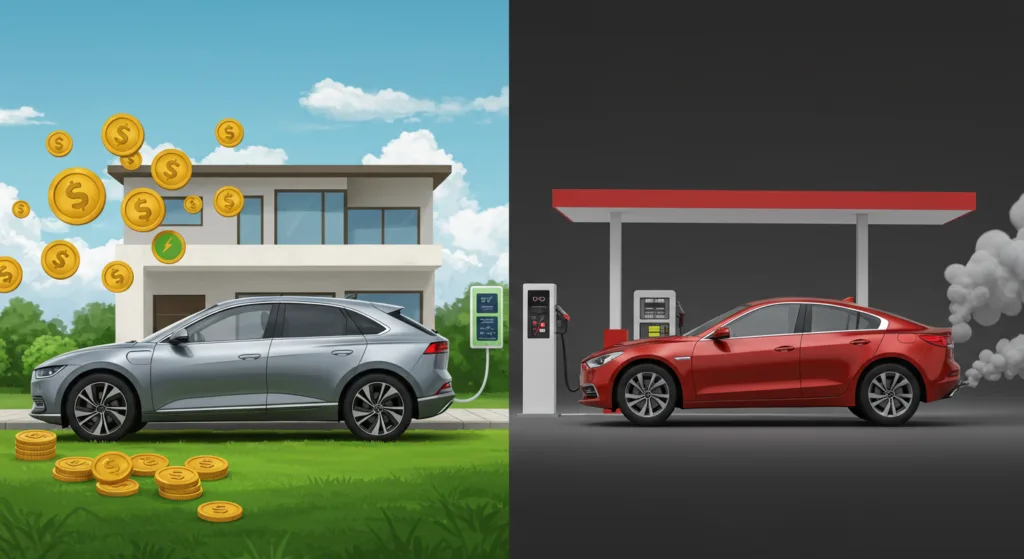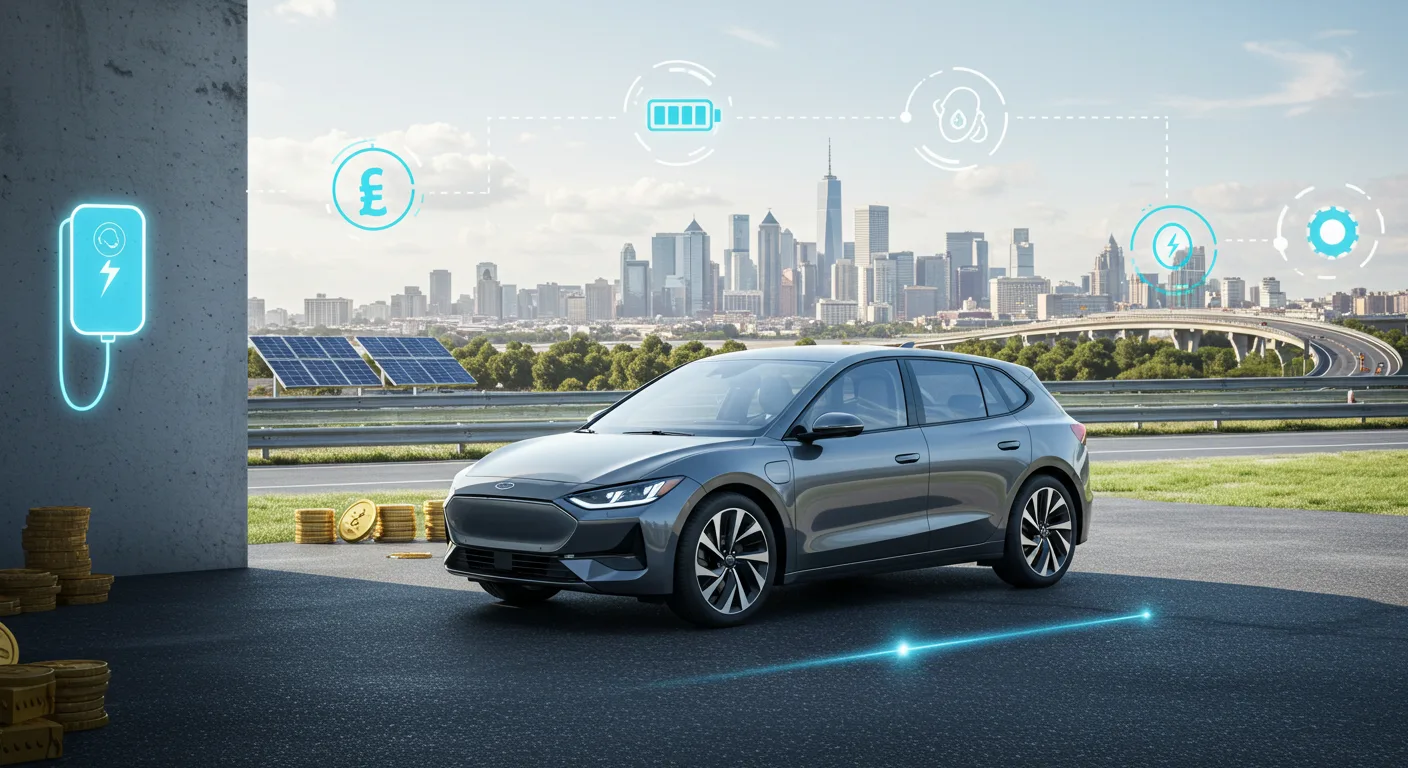1. Understand EV Range: How Far Can Electric Cars Really Go?

When it comes to electric car (EVs), range anxiety remains one of the most common concerns for first-time buyers. But EV range has improved dramatically over the last few years, making electric cars more practical than ever.
As of 2024, the average electric car range is approximately 250–300 miles (400–480 km) on a single charge. Some models like the Lucid Air or Tesla Model S Long Range go beyond 400 miles (640 km) under ideal conditions.
Factors That Affect EV Range:
- Battery size (kWh): Larger batteries offer more range.
- Driving style: Aggressive acceleration drains the battery faster.
- Speed: Highway driving consumes more energy than city driving.
- Climate: Cold weather can reduce range by 15–40%.
- Weight and load: More passengers or cargo = more energy needed.
- Use of climate control: Heating and A/C can impact consumption.
Examples of Real-World Ranges:
| Model | EPA Range (mi) | Battery Size (kWh) |
|---|---|---|
| Tesla Model 3 LR | 358 | 82 |
| Hyundai Ioniq 6 | 361 | 77.4 |
| Chevrolet Bolt EUV | 247 | 65 |
| Nissan Leaf S Plus | 226 | 62 |
| Ford Mustang Mach-E SR | 250 | 70 |
- Which brand of electric scooter is best?
- Do you need a license for an electric scooter in the USA?
- Are electric cars high maintenance?
- What are the most reliable electric cars?
- What is the lifespan of an electric car?
2. Charging Infrastructure: Where and How to Charge Your Electric Vehicle

Charging your electric car is not like stopping at a gas station — it’s a new routine. The good news? EV charging infrastructure is expanding rapidly, especially in North America and Europe.
1- Types of EV Charging:
- Level 1 (120V): Standard home outlet. Adds ~3–5 miles of range per hour.
- Level 2 (240V): Home or public station. Adds ~20–30 miles of range per hour.
- DC Fast Charging (Level 3): Adds 80% charge in 20–40 minutes. Ideal for road trips.
2- Where Can You Charge?
- At Home: Over 80% of EV owners charge at home overnight using Level 2 chargers.
- At Work: Many companies now offer free or discounted EV charging for employees.
- Public Stations: Over 165,000 public chargers in the U.S. and 500,000+ in Europe (as of late 2023).
- Fast Charging Networks:
- Tesla Supercharger: Over 50,000 worldwide, open to non-Tesla EVs in some areas.
- Electrify America: 800+ fast-charging stations in the U.S.
- IONITY (Europe): Growing high-speed network across highways.
3- Apps That Make Charging Easier:
- PlugShare
- ChargePoint
- ABRP
- EVgo
- Tesla App
Tip for Buyers:
Before buying, check the availability of chargers in your area and along your commute. Having accessible charging near your home or workplace makes a massive difference.
3. Battery Life and Warranty: What You Need to Know About EV Batteries

The battery is the heart of any electric car — and arguably the most expensive component. So, naturally, buyers want to know how long it will last and what kind of warranty coverage they can expect.
1- How Long Do EV Batteries Last?
Modern lithium-ion EV batteries are designed to last 10–20 years or 200,000–300,000 miles before significant degradation. According to studies by Recurrent and BloombergNEF:
- Most EVs retain over 80% of their battery capacity after 8 years.
- Tesla batteries degrade at roughly 1% per year on average.
- Nissan Leaf batteries tend to degrade faster due to lack of liquid cooling in early models.
2- Warranty Coverage:
In most countries, EV manufacturers offer separate warranties for the battery and the car:
| Brand | Battery Warranty | Coverage Details |
|---|---|---|
| Tesla | 8 years / 100,000–150,000 mi | Retain 70% capacity |
| Hyundai/Kia | 10 years / 100,000 mi | Industry-leading, covers defects & capacity |
| Nissan | 8 years / 100,000 mi | Covers battery failure, not degradation |
| Ford | 8 years / 100,000 mi | Covers performance and defects |
| Volkswagen ID.4 | 8 years / 100,000 mi | Covers 70% capacity retention |
3- Can EV Batteries Be Replaced?
Yes, but it can be costly. Replacement battery prices vary:
- Chevy Bolt: ~$16,000
- Tesla Model 3: ~$13,000–$15,000
- Nissan Leaf: ~$5,500–$7,500 (varies by age/model)
However, as battery technology advances and solid-state batteries enter the market (expected from 2026 onward), longevity and pricing will improve.
4- Tips to Extend Battery Life:
- Avoid charging to 100% daily (80–90% is ideal).
- Don’t let the battery drop below 10% often.
- Use Level 2 charging for daily use instead of frequent fast charging.
- Park in the shade or garage to avoid heat exposure.
Understanding battery health helps you make smarter buying decisions and gives you more confidence in the long-term value of your EV.
4. Total Cost of Ownership: EV vs Gas Cars in the Long Run

One of the biggest misconceptions about electric vehicles (EVs) is that they’re too expensive. While the initial purchase price may be higher than gas cars, the total cost of ownership (TCO) often tells a different story — especially over 5 to 10 years.
Upfront Costs
- EVs are typically $5,000–$10,000 more expensive than their gas counterparts.
- However, federal and local incentives (see next section) can significantly reduce this gap.
Operating Costs: The Real Savings
Let’s break it down:
⚡ Fuel Costs (Electricity vs Gas):
- Average U.S. gas price (2024): $3.50/gallon
- Average EV charging cost (home): $0.13/kWh
- Driving 1,000 miles:
- Gas car (25 mpg): ~$140
- EV (3.5 mi/kWh): ~$37
Estimated annual savings on fuel: $800–$1,200
🔧 Maintenance Costs:
- EVs have fewer moving parts — no oil changes, timing belts, spark plugs, etc.
- According to Consumer Reports, EV owners spend 50% less on maintenance over the vehicle’s life.
- Tesla and Nissan EVs average $0.03/mile in maintenance, while gas cars are closer to $0.10/mile.
🚘 Resale Value and Depreciation:
- EVs used to depreciate faster, but that trend is shifting.
- Models like the Tesla Model Y and Ford Mustang Mach-E now retain value well due to demand and tech updates.
- Battery health remains a key factor in used EV pricing.
Real-World Example:
| Metric | Toyota Camry (Gas) | Tesla Model 3 (EV) |
|---|---|---|
| Purchase Price | $28,000 | $40,000 |
| 5-Year Fuel Cost | ~$7,000 | ~$2,000 |
| 5-Year Maintenance Cost | ~$3,000 | ~$1,200 |
| Federal Tax Credit | N/A | -$7,500 |
| Total 5-Year Cost | $38,000 | $35,700 |
Despite a higher MSRP, the EV ends up cheaper after five years. Over 10 years, the savings can exceed $10,000.
5. Government Incentives and Tax Credits for Buying an Electric Car

Government support is one of the biggest perks of buying an EV. Depending on where you live, you could qualify for thousands of dollars in credits, rebates, and perks.
United States (as of 2024):
Federal Tax Credit: Up to $7,500
- Applies to new EVs assembled in North America with eligible battery components.
- Income limits apply: $150,000 for individuals, $300,000 for joint filers.
- Credit is now available at point of sale through dealerships.
Used EV Credit: Up to $4,000
- For EVs under $25,000 and at least 2 years old.
- Income caps are lower than new EV credit.
Charging Equipment Credit:
- 30% credit (up to $1,000) for installing a home EV charger.
- Must be placed in a primary residence in an eligible area.
European Union:
- France: Up to €7,000 bonus for new EVs under €47,000.
- Germany: Up to €4,500 environmental bonus (2024), phasing out soon.
- Netherlands & Norway: Exemptions on VAT, road tax, and more.
Canada:
- Federal rebate up to $5,000.
- Provincial programs: BC and Quebec offer up to $7,000 more.
Other Incentives Around the World:
- Free or discounted tolls
- Access to HOV lanes
- Free parking for EVs in some cities
- Lower registration and insurance fees
Pro Tip:
Always check your local utility provider, state, or municipal website — many offer rebates for chargers, solar panels, or off-peak charging programs.
6. Home Charging Options: Installing an EV Charger at Home

Charging at home is the most convenient and cost-effective way to keep your EV powered. Over 80% of EV owners charge at home — and it’s easy to understand why: you start every day with a full “tank.”
1- Charging Levels for Home Use:
🔌 Level 1 Charging (Standard Outlet):
- Uses a regular 120V wall outlet.
- Charging rate: 3–5 miles/hour.
- Best for plug-in hybrids or low-mileage drivers.
- No installation required — plug and play.
⚡ Level 2 Charging (240V Outlet):
- Requires a 240V circuit — like what a dryer uses.
- Charging rate: 20–40 miles/hour.
- Fully charges most EVs overnight.
- Installation by a licensed electrician is recommended.
2- Installation Cost and Process:
- Equipment: Level 2 charger prices range from $400–$1,200.
- Installation: $500–$2,000, depending on panel capacity, distance, and permits.
- Total cost: Around $1,000–$3,000 before rebates.
3- Popular Home Charger Brands:
- ChargePoint Home Flex
- Tesla Wall Connector
- JuiceBox 40
- Grizzl-E Classic
4- Smart Charging Features to Look For:
- WiFi/Bluetooth control via app
- Schedule charging during off-peak hours
- Energy monitoring and consumption reports
- Lockout feature for security
5- Can You Use Solar Power?
Absolutely. Pairing your home charger with solar panels allows for zero-emission driving and zero electricity cost. Some setups also integrate with home batteries like Tesla Powerwall.
7. Performance and Acceleration: Are Electric Cars Faster Than Gas Cars?

Yes — electric cars are generally faster off the line than gas-powered vehicles. That’s not just marketing hype. EVs deliver instant torque, meaning power is available immediately, with no gear shifts or engine lag.
Why Are EVs So Quick?
- Electric motors deliver 100% torque instantly.
- No need to rev the engine or shift gears.
- Battery placement gives EVs a low center of gravity, improving handling.
Real-World Acceleration Times:
| Model | 0–60 mph (sec) | Powertrain Type |
|---|---|---|
| Tesla Model S Plaid | 1.99 | Tri-motor electric |
| Porsche Taycan Turbo S | 2.6 | Dual-motor electric |
| Ford Mustang Mach-E GT | 3.5 | Dual-motor electric |
| BMW M3 (Gas) | 3.8 | Turbocharged V6 |
| Toyota Camry XSE (Gas) | 5.8 | V6 |
Even mainstream EVs like the Tesla Model 3, Kia EV6, or Hyundai Ioniq 5 offer sports-car-like acceleration in their dual-motor variants.
Beyond Speed: Handling and Ride
- Regenerative braking offers more control and energy efficiency.
- Many EVs come with adaptive suspension, offering a smoother ride.
- AWD (All-Wheel Drive) is common in dual-motor EVs for added grip and safety.
Whether you’re looking for speed or smooth daily commuting, EVs outperform expectations.
8. Maintenance Costs and Reliability of Electric Vehicles

EVs are simpler and cheaper to maintain than gas-powered vehicles. With fewer moving parts, there’s simply less that can go wrong.
1- What EVs Don’t Need:
- Oil changes
- Transmission servicing
- Timing belts
- Spark plugs
- Exhaust systems
- Fuel filters
2- Common EV Maintenance Tasks:
- Brake pads: Last longer thanks to regenerative braking
- Coolant: For battery and motor systems (intervals vary)
- Cabin air filter
- Tire rotation and replacement
3- Real-World Cost Comparisons:
According to Consumer Reports (2023):
| Cost Over 5 Years | EVs | Gas Cars |
|---|---|---|
| Maintenance & Repairs | ~$1,200 | ~$3,000 |
| Annual Maintenance Avg | ~$240/year | ~$600/year |
EVs save you about $1,800+ over five years on maintenance alone.
4- Reliability Rankings:
- Tesla, Hyundai, and Kia EVs rank high in EV reliability.
- Older Nissan Leaf models had battery issues (mainly due to no thermal management).
- EVs generally have fewer recalls related to engine or emissions.
Regular software updates — especially in Teslas — can also fix issues remotely, reducing the need for service visits.
9. Resale Value and Depreciation Rates of Electric Cars

Resale value has historically been a weak point for EVs — but that’s changing fast. With growing demand, better battery tech, and improved infrastructure, EV depreciation is narrowing the gap with gas cars.
1- What Affects EV Depreciation?
- Battery health and warranty status
- Original price and brand reputation
- Charging availability in the region
- Updates (tech, software, features)
- Government incentives (which lower used EV pricing)
2- Depreciation Examples (After 3 Years):
| Model | Original MSRP | Value After 3 Years | Depreciation % |
|---|---|---|---|
| Tesla Model 3 | $45,000 | $31,000 | ~31% |
| Chevy Bolt EV | $36,000 | $18,000 | ~50% |
| Ford Mustang Mach-E | $48,000 | $30,000 | ~38% |
| Toyota Camry (Gas) | $28,000 | $21,500 | ~23% |
Tesla leads the pack with strong resale value due to software updates, charging access, and brand loyalty.
3- How to Protect Resale Value:
- Charge between 10%–90% to extend battery life.
- Keep service records.
- Avoid excessive fast charging (Level 3) when unnecessary.
- Sell or trade in while battery is still under warranty.
10. Choosing the Right EV Model for Your Lifestyle and Budget

The EV market is booming with over 100 models globally, from compact city cars to luxury SUVs and work trucks. Choosing the right one depends on your driving needs, charging setup, and budget.
Key Questions to Ask Yourself:
- How far do you drive daily?
- Less than 50 miles/day? A small EV or PHEV could work.
- Frequent road trips? Look for 300+ mile range and fast charging.
- Do you have access to home charging?
- If yes, more flexibility in range and battery size.
- If not, prioritize vehicles with fast-charging capability and public network access.
- What’s your budget?
- Entry-level EVs: Chevy Bolt, Nissan Leaf, Hyundai Kona EV (~$25k–$35k)
- Mid-range: Tesla Model 3, VW ID.4, Kia EV6 (~$40k–$55k)
- Premium: Tesla Model S, BMW iX, Lucid Air ($70k+)
- Need space for family or gear?
- Best EVs for families: Hyundai Ioniq 5, Kia EV9, Ford Mustang Mach-E
- Compact options: Mini Cooper SE, Fiat 500e
Bonus Tips:
- Check EPA efficiency rating (MPGe) — the higher, the better.
- Look for vehicles eligible for tax credits or state incentives.
- Test-drive more than one model — EV driving feels very different from gas cars.
Choosing the right EV means balancing range, comfort, tech, and budget. With a little research, you’ll find a model that fits your life perfectly.
Buying an electric car is more than just a trend — it’s a smart, sustainable choice. From understanding range and charging to comparing long-term costs, battery health, and performance, you now have the key insights to choose the right EV for your lifestyle and budget.
If this guide helped you, please share it on social media to help others make informed decisions too! 🚗⚡💬



